
Based on our proprietary polymer synthesis technology, PolyJet DNA In Vitro Transfection Reagent is formulated as a biodegradable polymer based DNA transfection reagent that ensures effective and reproducible transfection on HEK293, COS-7, NIH-3T3, HeLa, CHO and a broad ranges of hard-to-transfect mammalian cells. PolyJet reagent is able to immobilize DNA migration during electrophoresis at very low concentration and form transfection complex within 5 minutes at RT. A remarkable feature of the reagent is the rapid and complete degradation of polymer after transfection complex endocytosis (Figure 1), leading to much less cytotoxicity. PolyJet reagent, 1.0 ml, is sufficient for ~667 transfections in 24 well plates or ~333 transfections in 6 well plates, providing a very affordable alternative to the leading products for transfecting a variety of commonly used and hard-to-transfect mammalian cells.
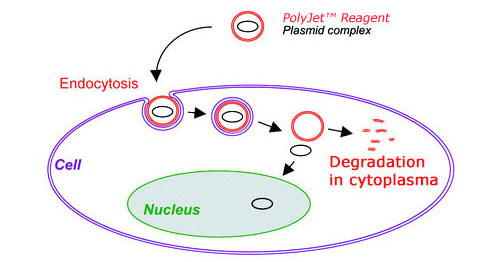
Figure 1. A Cartoon Showing Biodegradation of PolyJet DNA Transfection Reagent After Endocytosis of Transfection Complex
Features
- Bio-degradable after endocytosis
- Exceptional high titers of virus production
- Equally good for very long DNAs (>89 kb)
- Equally good for both single DNA transfection and multi DNA co-transfection
- High levels of recombinant protein production
- Simple & robust transfection procedure
- Very affordable
Storage Condition
Store at 4 °C. If stored properly, the product is stable for 12 months or longer.
Broad Transfection Spectrum for Mammalian Cell Types
|
Cell Lines |
Efficiency (% GFP) |
Cell Lines |
Efficiency (% GFP) |
| McArdle 7777 Hep3D SHEP 3T3-442A COS-7 CV-1 D 407 DHD Pro.b 3LL B16-F10 BAEC BHK-21 Ca Ski CaCo2 CHO HCS-2/8 HEK-293 HeLa HLMEC H-MVEC Huh-7D12 ATT20 SK-N-SH C2C12 HepG2 |
65-70% |
SAOS-2 |
58% |
Examples Showing Transfection Efficiency of PolyJet DNA In Vitro Transfection Reagent on Commonly Used Cells
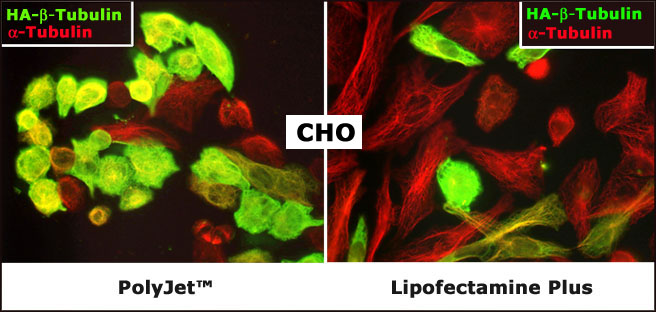
Transfection efficiency comparison of PolyJet vs. lipofectamine Plus on Chinese Hamster Ovary (CHO) cells. HA tagged beta-tubulin cDNA was delivered into CHO cells with PolyJet (left panel) and lipofectamine Plus (right panel) respectively. FITC conjugated antibody against HA tag was utilized to pick up HA-beta-tubulin (Green) while a DM1a antibody was used to detect endogenous alpha-tubulin followed by probing with rhodamine conjugated secondary antibody (Red). The above picture was provided by Dr. Shang Yin of University of Texas at Houston Medical School as courtesy
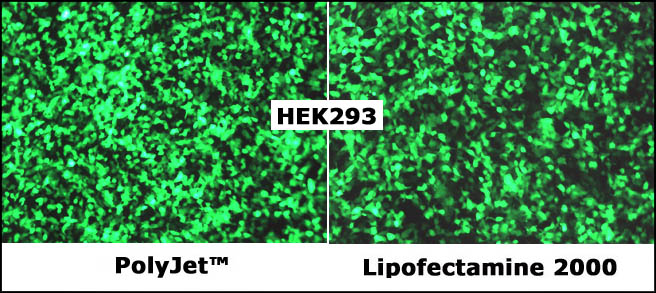
A comparison showing transfection efficiency of PolyJet reagent vs. a leading product, Lipofectamine 2000 on HEK293FT cells. HEK-293FT cells were transfected with GFP vector (pEGFP-N3) by PolyJet (left panel) and Lipofectamine 2000 (right panel) respectively. The cells were visualized by Nikon Eclipse Fluorescence microscope 24 hours post transfection
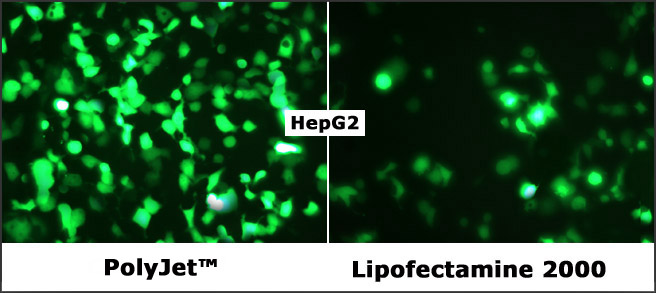
A comparison showing transfection efficiency of PolyJet reagent vs. a leading product, Lipofectamine 2000 on HepG2 cells. HepG2 cells were transfected with GFP vector (pEGFP-N3) by PolyJet (left panel) and Lipofectamine 2000 (right panel) respectively. The cells were visualized by Nikon Eclipse Fluorescence microscope 24 hours post transfection
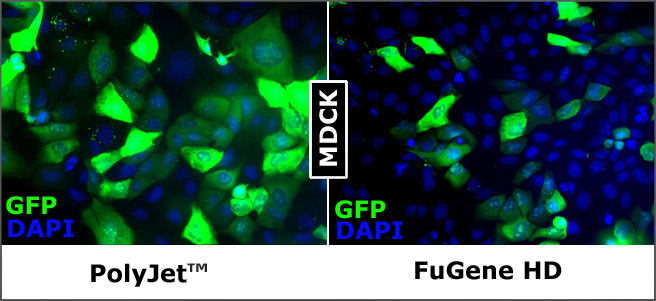
Transfection efficiency comparison of PolyJet vs. Fugene HD on MDCK cells. A plain GFP DNA was transduced into MDCK cells with PolyJet (left panel) and Fugene HD (right panel) reagents respectively per manufacturers' protocols. GFP and DAPI staining were visualized under fluorescence microscopy 48 hours post transfection. The above comparison data and pictures were completed and provided by Dr. Ge Zhou of NYU Medical Center as courtesy.
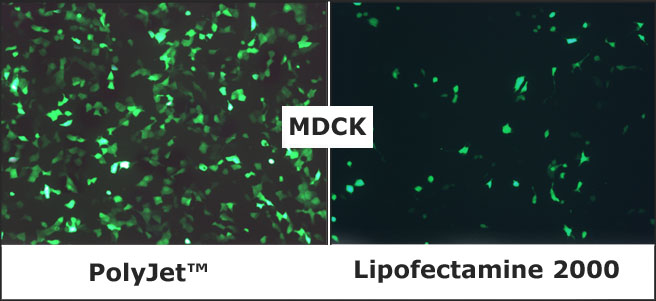
A comparison showing transfection efficiency of PolyJet reagent vs. a leading product, Lipofectamine 2000 on MDCK cells. MDCK cells are notoriously hard to transfect. With proprietary "Shaved Cell Transfection" protocol, PolyJet (left panel) gives up to 70% GFP positive cells vs. Lipofectamine 2000 (right panel) around 5% efficiency. MDCK cells were transfected with GFP vector (pEGFP-N3) by PolyJet (left panel) and Lipofectamine 2000 (right panel) respectively. The cells were visualized by Nikon Eclipse Fluorescence microscope 36 hours post transfection
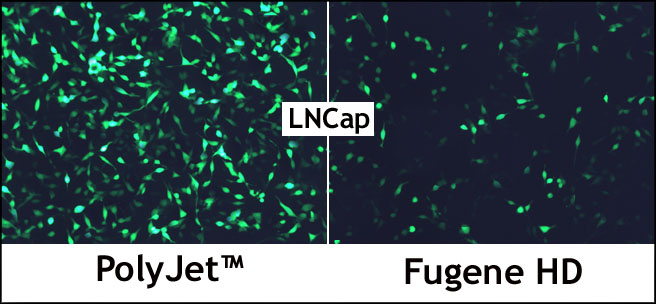
A comparison showing transfection efficiency of PolyJet reagent vs. a leading product, Fugene HD on LNCap cells. LNCap cells were transfected with GFP vector (pEGFP-N3) by PolyJet (left panel) and Fugene HD (right panel) respectively. The cells were visualized by Nikon Eclipse Fluorescence microscope 24 hours post transfection.
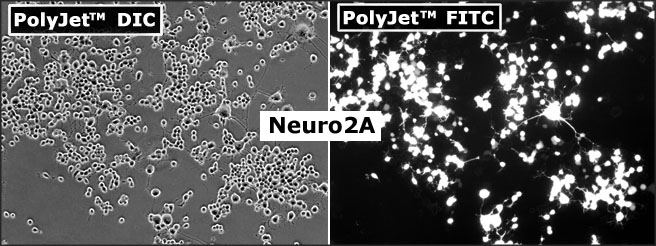
Neuro2A cells transfected with pEGFP-C1 plasmid using PolyJet In Vitro DNA Transfection Reagent.
The Neuro2A cells were visualized by Nikon Eclipse Fluorescence microscope with DIC phase imaging (left) and FITC imaging (right) 24 hours post-transfection
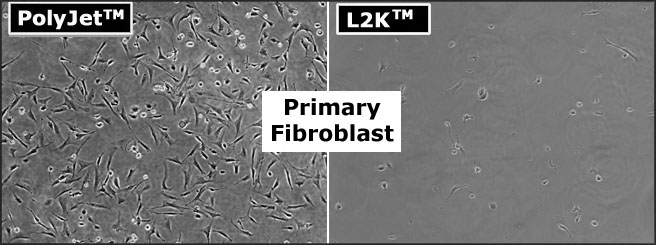
Comparison of cytotoxicity of PolyJet DNA In Vitro Transfection Reagent with L2K on primary murine skin fibroblast. The primary murine fibroblast was incubated with the indicated transfection reagents/pEGFP-C1 (DNA) complexes above for 4 hours in serum-free DMEM High Glucose medium followed by replacement of complete serum-containing medium. The cells were visualized by Nikon Eclipse Fluorescence microscope with DIC phase imaging 24 hours post transfection